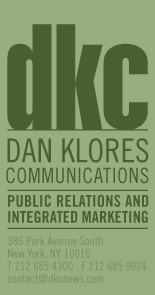
Copyright ©2005 Dan Klores Communications. All Rights Reserved.
The Latest from Sean
Cassidy
Twitter on Mars
Lately, I have been obsessed with the show Life on Mars, the ABC police drama about Sam Tyler (Jason O'Mara), an NYPD detective who is mysteriously and inexplicably transported from 2008 back in time to the fictional 125th precinct of 1973.
Surrounded by mutton-chopped, plaid pants, polyester suit-wearing squad room characters played by Harvey Keitel and Michael Imperioli, Detective Tyler is trapped in an era with no forensic high technology—a lab report takes weeks—and no PCs, PDAs or cell phones. Social networking seems to only happen in a Blarney Stone and references to facebook likely point to bound pictures of bad guys.
Since it doesn't appear Detective Tyler will be returning to the CSI-equipped Bloomberg era anytime soon, he must rely solely on his instincts, vision and experience to get by as a police officer. It is these qualities that enable him to impressively solve crimes and co-exist with a crew of old school detectives (who cynically—and sadly—suspend civil liberties as readily as the viewer must suspend disbelief).
As DKC introduces its first newsletter—in which we will present some very successful and elaborate experiential and digital campaigns; chat about the evolving nature of the industry; and highlight a few big-budget national programs—I find myself thinking about Detective Tyler’s policing skills.
Blogs, digital technology, Blackberrys, up-to-the-minute information dissemination systems, YouTube, Facebook and Twitter are essential to effective public relations. But, we also must remember that these innovations, not unlike big activation budgets, are tools—imperative and hugely useful tools, but still tools—that support superior marketing and public relations expertise.
As DKC goes full-bore into the digital era, I find myself telling clients and colleagues that the greatest campaigns still stem from great instincts and knowledge-driven ideas that 1) create emotional connectivity with the target audience, and 2) resonate across both new and traditional media. Several of our most successful campaigns over the last 18 months were born in new media but gained traction with traditional media because they were rooted in great ideas.
A great idea funneled through the multi-platform channels of the digital era can—with previously unimaginable speed—add hundreds of millions of dollars to a client’s bottom line. However, without a great idea or innovative approach as the foundation of a communications program, technological tools are just accessories.
I hope you enjoy this newsletter. Please read it at your leisure and e-mail me with any questions or comments at [email protected]. Also, check out Life on Mars—it could probably use the viewers.
Sean Cassidy
President, DKC
PS: I wrote this on my Blackberry.
Case Study
Delta’s SKY360° Gives First-Class Experience to New Yorkers
Introduction:
Experiential PR and marketing can be one of the most powerful ways to sell your brand. When done well, it gives the public a chance to live and breathe the brand while opening the door to expanded publicity opportunities. The DKC Hospitality and Lifestyle group recently achieved both with its creation of a destination experience for Delta Air Lines.
Timeframe:
October 3, 2007-March 15, 2008
Strategy:
New York City is a critical domestic and international market for Delta. To elevate the airline's profile and perception, DKC worked with the airline to develop "SKY360° by Delta," a multidimensional lounge in Manhattan created to bring Delta's in-flight experience to life on the ground. The space showcased Delta's award-winning in-flight experience and extensive global network of destinations.
SKY360° was programmed to attract visitors, secure enrollments for Delta's frequency flier program, SkyMiles, and of course, to generate extensive publicity. Furthermore, each aspect of Delta's on-board offerings was featured to heighten awareness for the airline's customer-focused offerings.
Tactics:
Programming for SKY360° included:
- A media open house to sample the on-board menu from noted chef Todd English and cocktails from celebrity night life guru Rande Gerber, master sommelier Andrea Robinson and celebrity chef Michelle Bernstein.
- An opening celebration honoring Food Bank for New York City, co-hosted by South Beach Wine + Food and attended by Brody Jenner, Audrina Patridge, Dylan Lauren and Delta's culinary "A Team," consisting of Todd English, Rande Gerber, Andrea Robinson and Michelle Bernstein.
- The sixth anniversary celebration of the Broadway smash "Mamma Mia," featuring a karaoke contest judged by cast members.
- The opening night celebration of Second Stage Theatre's "Edward Albee's Peter and Jerry," attended by Bill Pullman, Dallas Roberts, Edward Albee, Mercedes Ruehl, Tyne Daly, Joan Rivers and other notables.
- New Yorkers for Children's Annual "Wrap to Rap" party hosted by Delta and attended by 60 children from the organization's foster care system and featuring special appearances from LeAnn Rimes, Damon Dash and Rachel Roy.
Results:
The success of "SKY360° by Delta" greatly surpassed the client's goals and expectations, achieving the following measurable results in a six week period:
- Over 25,000 visitors to the space
- Over 750 guests enrolled in Delta SkyMiles
- Over $3.3 million in calculated advertising equivalency
Delta Air Lines was so pleased with the results of SKY360° that it extended the initial six week period until December 31 and, after reviewing written customer feedback regarding satisfaction with visits to the lounge, again extended the lease through the end of March 2008.
Opinion
The Digital Campaign: Content is King
Facebook, YouTube, Twitter. Today's public relations professional has access to an endless array of digital tools to communicate in more targeted and exciting ways.
More than ever, the medium is the message, and any discussion of form must be subject to an identification of audience and the content that speaks to that audience. Given the often overwhelming scope of information available through these online and mobile channels, a careful approach to content is essential to achieving a standout digital campaign.
The Web 2.0 generation is defined by demand for personalization and a sense of ownership in the brand. Content creation in the digital sphere means not only catering to an audience's needs through online channels, but also creating a virtual space for this audience to "live." It is no longer sufficient just to feed the community information. They want to put their own stamp on the brand as a part of the content creation process.
Demonstrating to your audience that you understand its needs is the key differentiator between a successful and failed digital campaign. The most effective campaigns incorporate a spirit of collaboration that is perceived as authentic by the community, and start with compelling content that speaks to your core audience. The delivery medium may be different, but the fundamental principle is the same: content is king.
Once the content is there, a host of tactics can lay the groundwork for a well-received campaign, such as inviting influential voices to guest blog on your site, offering contests and promotions, and establishing relevant discussion forums. This approach will help you forge an inclusive partnership between the brand and a community of evangelists who will preach loyalty.
The distribution outlets you utilize also play a significant role in the community's perception of the content. For example, it makes sense for a MySpace page to be part of the digital strategy of a rock band, given the social network's standing as a fertile ground for budding musicians. However, the same tactic may be the wrong fit for the latest household cleaner from P&G. In the case of Delta Air Lines, DKC worked on a series of digital shorts that poke fun at air travel. The "Planeguage" spots, posted on YouTube, drove traffic to Delta.com while generating international publicity. Given Delta's targeted audience, this viral video approach was more effective than a social networking campaign. The bottom line is there is no one-size-fits-all digital strategy, and each brand must be selective in making its choices for distribution.
Digital public relations campaigns will undoubtedly undergo adjustments in approach and practice as the medium itself continues to transform. The good news is companies are embracing digital strategy at the highest levels. And as is often the case, the basics remain true: know your audience, and provide it with high-quality content delivered in appropriate form.Introduction to DKC
DKC 101: A Primer for Clients New and Old
When DKC first opened its doors 17 years ago, it began with a small but committed staff, a handful of clients, and a lot of big ideas. Over the years, DKC has grown to its current standing as one of the top ten largest independent PR agencies in the country, with expertise in a wide variety of industries. In that time, our business has evolved, but the core principles that have always defined DKC remain true: we're a results-focused agency that brings enthusiasm, creativity, and an entrepreneurial spirit to each and every client account.
We're big believers in the idea that a team-based approach to PR leads to superior results for our clients. DKC has a culture that's free of silos, meaning that we're free to form account teams across practice areas. We find that this leads to creative problem solving and original thinking while creating a stimulating work environment for our 140 person staff.
DKC has always distinguished itself through its thorough understanding of the media. We're in daily contact with the editors, reporters, and producers that matter to our clients, across all media – print, broadcast, and online. Complementing our strong set of relationships, we utilize an approach that looks to place brands in unexpected places. This has included Citi in the style pages and Rachael Ray in the sports pages. The result is unsurpassed coverage that builds awareness and effectively positions clients' brands.
Because we're a full-service agency, we're able to assist our clients in any number of capacities, including: integrated marketing (creating strategic connections between our clients), brand launches, re-branding campaigns, experiential marketing, online/viral marketing, special events, and crisis management.
Our expertise encompasses a variety of practice areas including: consumer products, corporate, media, entertainment, music, fashion, government relations, not-for-profit, education, health care, hospitality, lifestyle, technology, sports, and film.
Our diverse client roster reflects the array of industries we work within. It includes some of the most prominent, well-respected institutions and companies in the United States: Delta Air Lines, Sprint, Microsoft, United Technologies Corporation, Marvel Entertainment, Kraft Brands, Sheraton, Radio One, Inc., and New Balance Athletic Shoe Company. Among the companies we have helped to grow over time are: Junior's Cheesecake, Veoh, David Barton Gym, Dylan's Candy Bar, and TheFilter.com. Our not-for-profit clients have included The Children's Health Fund, The Fund for Veterans' Education, the National Constitution Center, and Stony Brook University.
















